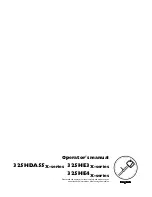
8
CAUSES AND OPERATOR PREVENTION OF
KICKBACK
– cont’d
When the blade is binding, or when
interrupting a cut for any reason, release the
trigger and hold the saw motionless in the
material until the blade comes to a complete
stop. Never attempt to remove the saw from
the work or pull the saw backward while the
blade is in motion or kickback may occur.
Investigate and take corrective actions to
eliminate the cause of blade binding.
When restarting a saw in the workpiece,
center the saw blade in the kerf and check
that saw teeth are not engaged into the
material.
If the saw blades are binding, it may
walk up or kickback from the workpiece as the
saw is restarted.
Support large panels to minimize the risk of
blade pinching and kickback.
Large panels
tend to sag under their own weight. Supports
must be placed under the panel on both sides,
near the line of cut and near the edge of the
panel.
Do not use dull or damaged blades.
Unsharpened or improperly set blades produce
narrow kerf causing excessive friction, blade
binding and kickback.
ADDITIONAL SPECIFIC SAFETY RULES
Use extra caution when making a "plunge
cut" into existing walls or other blind areas.
The protruding blade may cut objects that can
cause kickback.
Check the lower guard for proper closing
before each use. Do not operate the saw if
the lower guard does not move freely and
close instantly. Never clamp or tie the lower
guard into the open position.
If the saw is
accidentally dropped, the lower guard may be
damaged. Raise the lower guard with the
retracting handle and make sure it moves freely
and does not touch the blade or any other part
in all depths of cuts.
Check the operation of the lower guard
spring. If the guard and the spring are not
operating properly, they must be serviced
before use.
The lower guard may operate
sluggishly due to damaged parts, gummy
deposits, or a build-up of debris.
The lower guard should be retracted
manually only for special cuts such as
"plunge cuts" and "compound cuts". Raise
lower guard by retracting handle and as
soon as the blade enters the material, the
lower guard must be released.
For all other
sawing, the lower guard should operate
automatically.
Always observe that the lower guard is
covering the blade before placing saw down
on the bench or on the floor.
An unprotected,
coasting blade will cause the saw to walk
backwards, cutting whatever is in its path. Be
aware of the time it takes for the blade to stop
after the switch is released.
Never operate the saw while it is being carried
to another location. The blade guard may be
open and potentially cause serious injury.
If the switch fails to turn the saw ON or OFF
properly, stop using it immediately and have the
saw switch repaired.
Always allow the saw to reach full speed before
beginning the cut.
Never use the side of the blade for cutting.
When making horizontal cuts, make sure the
weight of the tool is not forcing the side of the
blade to do the cutting. This will reduce the risk
of kickback.
Make sure there are no nails or foreign objects
in the area of the workpiece to be cut.
Never lay workpiece on hard surfaces like
concrete, stone, etc.
The protruding blade may
cause tool to jump.
DANGER:
To avoid injury from
accidental starting, always remove the plug
from the power source before making any
adjustments and before installing or
removing a saw blade.
SPECIFIC SAFETY RULES
!
Содержание 241-0741
Страница 18: ...18 EXPLODED VIEW...
Страница 21: ...21 NOTES...
Страница 22: ...22 NOTES...
Страница 24: ...24 2013 Menard Inc Eau Claire WI 54703 11 12 2012...









































